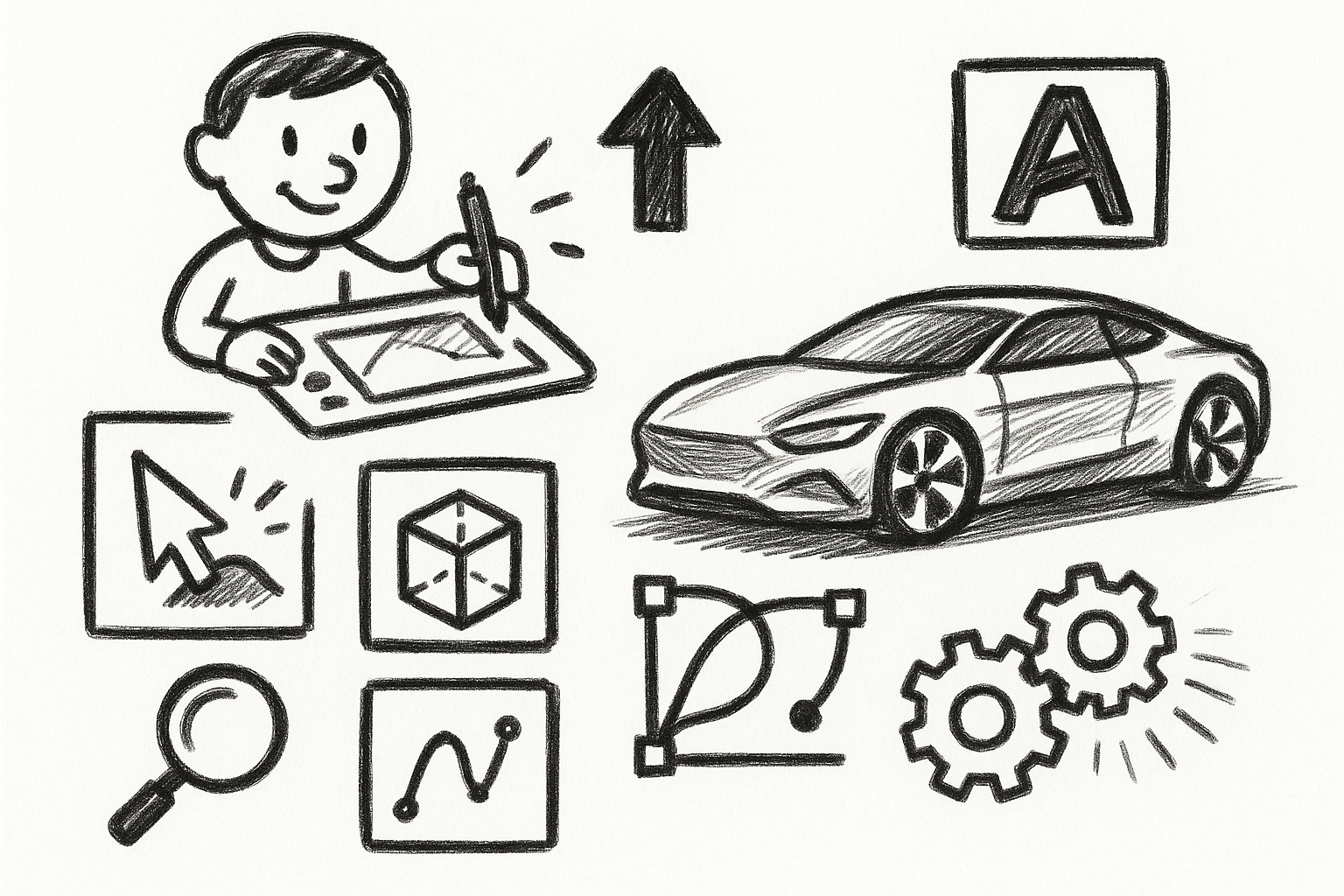Your Cart is Empty
Customer Testimonials
-
"Great customer service. The folks at Novedge were super helpful in navigating a somewhat complicated order including software upgrades and serial numbers in various stages of inactivity. They were friendly and helpful throughout the process.."
Ruben Ruckmark
"Quick & very helpful. We have been using Novedge for years and are very happy with their quick service when we need to make a purchase and excellent support resolving any issues."
Will Woodson
"Scott is the best. He reminds me about subscriptions dates, guides me in the correct direction for updates. He always responds promptly to me. He is literally the reason I continue to work with Novedge and will do so in the future."
Edward Mchugh
"Calvin Lok is “the man”. After my purchase of Sketchup 2021, he called me and provided step-by-step instructions to ease me through difficulties I was having with the setup of my new software."
Mike Borzage
Design Software History: Evolution of Design Software in Civil Engineering: From Manual Drafting to Advanced 3D Modeling and BIM Integration
January 03, 2025 8 min read


Early Beginnings of Design Software in Civil Engineering
Historical Context and Need
In the mid-20th century, civil engineering faced unprecedented challenges as nations embarked on ambitious infrastructure projects to rebuild and modernize after the devastation of World War II. The demand for efficient transportation systems, robust urban development, and monumental structures surged, necessitating advancements in engineering methodologies. Traditional drafting, the cornerstone of civil engineering design, relied heavily on manual drawing techniques using pencils, ink, and paper. This labor-intensive process was not only time-consuming but also prone to human error, which could lead to significant setbacks in large-scale projects. The need for greater precision and efficiency became increasingly apparent as projects grew in complexity. Engineers and designers sought methods to streamline the design process, reduce errors, and improve collaboration among multidisciplinary teams. The limitations of manual drafting highlighted the urgent need for technological solutions that could handle the intricate demands of modern civil engineering. This period set the stage for the emergence of computer-aided design, which promised to revolutionize the way engineers conceptualized and executed their projects.
Initial Software Development
The inception of design software in civil engineering can be traced back to the early 1960s, when pioneering individuals and organizations began exploring the potential of computers beyond mere computation. One of the key innovators was Dr. Ivan Sutherland, who developed the Sketchpad system in 1963 at MIT. Sketchpad is often considered the progenitor of all modern CAD systems, introducing the concept of using a graphical interface to create and manipulate objects directly on a computer screen. This groundbreaking work demonstrated that computers could be used for graphical design tasks, fundamentally changing the perception of how machines could assist in engineering. Companies like IBM and General Motors also played significant roles in advancing CAD technology. In 1964, General Motors collaborated with IBM to develop DAC-1 (Design Augmented by Computers), one of the first significant CAD systems used in the automotive industry, which subsequently influenced civil engineering applications. By the late 1960s, software specifically tailored for civil engineering began to emerge. Programs like the Computer-Aided Design and Drafting (CADD) systems were developed to address the specific needs of civil engineers, enabling them to create more accurate designs with greater efficiency than ever before. The introduction of CAD for civil use marked a pivotal shift, setting a new course for the industry and paving the way for future innovations in design and engineering software.
Evolving Capabilities: From 2D Drafting to 3D Modeling
2D Drafting Tools
The advent of 2D drafting tools in the 1970s and 1980s brought a transformative change to civil engineering design practices. Software such as AutoCAD, introduced by Autodesk in 1982, became a ubiquitous tool for engineers. AutoCAD provided civil engineers with the ability to create detailed two-dimensional drawings with unprecedented precision and flexibility. Compared to manual drafting, these tools significantly enhanced accuracy by reducing human error and allowing for easy modifications and adjustments. The efficiency gains were substantial; tasks that once took days or weeks could now be completed in hours. Engineers could now store vast amounts of design data electronically, share it seamlessly with colleagues, and maintain consistent documentation throughout the project lifecycle. The standardization of design elements and the ability to reuse components further streamlined the design process. This period also saw the rise of other notable software like MicroStation by Bentley Systems, which catered specifically to the needs of infrastructure and civil projects. These early CAD tools laid the foundational infrastructure for digital design, establishing methodologies and workflows that would evolve with advancing technology. Despite being limited to two dimensions, these tools represented a significant leap forward from traditional methods, setting a new standard for accuracy and productivity in the industry.
Transition to 3D Modeling
The transition from 2D drafting to 3D modeling marked a revolutionary phase in design software capabilities during the late 20th century. Technological breakthroughs, particularly in computing power and graphics processing, enabled software developers to create more sophisticated tools that could handle complex three-dimensional representations of structures. Software such as CATIA by Dassault Systèmes and later versions of AutoCAD introduced 3D modeling features that allowed civil engineers to visualize projects in a more realistic and detailed manner. The impact of 3D capabilities on planning and simulation was profound. Engineers could now perform spatial analyses, detect potential conflicts in design, and conduct structural simulations before any physical construction began. This led to improved design accuracy, reduced material wastage, and minimized costly on-site changes. The ability to create virtual models of projects facilitated better communication among stakeholders, as complex ideas could be conveyed more effectively through visualizations. Additionally, 3D modeling software began to incorporate parametric design features, where changes to one aspect of the model would automatically update related components, further enhancing efficiency. The move to three-dimensional design not only improved the quality and efficiency of civil engineering projects but also opened the door to more innovative and ambitious designs that were previously difficult to conceptualize and execute with 2D tools.
Integration with Engineering and Construction Processes
Interdisciplinary Collaboration
As design software evolved, it began to support a wide array of civil engineering disciplines, fostering greater interdisciplinary collaboration. Software platforms started to integrate functionalities that catered to structural analysis, environmental engineering, transportation planning, and more. For instance, Bentley Systems developed comprehensive solutions like STAAD.Pro for structural analysis and design, facilitating engineers to perform complex calculations within the same environment as their design models. The integration with architectural design software became increasingly important, enabling civil engineers and architects to work in tandem seamlessly. Tools like Autodesk Revit emerged as powerful Building Information Modeling (BIM) platforms that unified various aspects of a project into a single, coherent model. BIM allowed for the incorporation of detailed information about every component of a building or infrastructure project, from materials and structural details to energy performance data. This holistic approach improved coordination among different teams, reduced the likelihood of errors, and enhanced the overall quality of the project. Collaborative features such as shared models, real-time updates, and cloud-based storage facilitated communication and ensured that all stakeholders had access to the most up-to-date information. This convergence of technologies and disciplines within design software represented a significant advancement in how civil engineering projects were conceptualized, designed, and executed.
Construction and Project Management
The role of design software expanded beyond mere drafting and modeling to become a critical tool in managing large-scale civil engineering projects. The implementation of Building Information Modeling (BIM) transformed the way projects were planned, executed, and monitored. BIM platforms provided an integrated approach to design, construction, and facility management by allowing for the creation of digital representations of physical and functional characteristics of places. Companies like Trimble and Autodesk developed software solutions that combined 3D modeling with scheduling, cost estimation, and resource management. Key features of modern design software in construction management include:
- Integrated scheduling and cost estimation: Allows for accurate project timelines and budgets.
- Construction simulation: Enables visualization of the construction process to optimize workflows.
- Risk management tools: Helps in identifying and mitigating potential project risks.
- Geographic Information Systems (GIS) integration: Facilitates better site analysis and planning.
This integration enabled more accurate project management, improved risk management, and enhanced decision-making capabilities. Construction simulation features allowed project managers to visualize the construction process step by step, identify potential bottlenecks, and optimize workflows. The convergence of design and project management tools empowered civil engineers to oversee projects from inception to completion with greater control and efficiency, ultimately leading to more successful outcomes and better infrastructure development.
Future Directions and Innovations
Recent Advancements
The landscape of civil engineering design software continues to evolve rapidly, with recent advancements incorporating cutting-edge technologies such as artificial intelligence (AI) and machine learning. Key technological trends in civil engineering software include:
- Artificial Intelligence and Machine Learning: Automate routine tasks and optimize design solutions.
- Cloud-based collaborative platforms: Enable real-time collaboration and access to powerful processing capabilities.
- Generative Design Software: Uses algorithms to generate multiple design alternatives based on specified parameters.
- Advanced Data Analytics: Provides insights into material performance, structural integrity, and maintenance schedules.
For example, software like Autodesk's Generative Design uses algorithms to generate multiple design alternatives based on specified parameters, allowing engineers to explore a wider range of solutions more efficiently. Machine learning algorithms analyze vast amounts of data to provide insights on material performance, structural integrity, and maintenance schedules. The development of cloud-based and collaborative design platforms has further revolutionized the industry. Cloud computing allows for greater scalability, real-time collaboration regardless of geographic location, and access to powerful processing capabilities without significant hardware investments. Platforms like BIM 360 enable teams to work on shared models simultaneously, streamline communication, and reduce delays caused by miscommunication or outdated information. These advancements not only enhance productivity but also promote more innovative and sustainable design practices by leveraging data and computational power to inform decision-making processes.
Future Prospects
Looking ahead, emerging technologies such as virtual reality (VR), augmented reality (AR), and digital twins hold the potential to further transform civil engineering design and construction. VR and AR technologies allow engineers and stakeholders to immerse themselves in a virtual representation of a project, providing a more intuitive understanding of scale, spatial relationships, and design aesthetics. This immersive experience facilitates better feedback and more informed decisions during the design phase. Digital twins—digital replicas of physical assets—enable real-time monitoring and analysis of infrastructure throughout its lifecycle. By integrating sensors and IoT devices, engineers can collect data on performance, predict maintenance needs, and optimize operations. The adoption of these technologies promises to enhance sustainable infrastructure development by allowing for more precise modeling of environmental impacts, energy consumption, and resilience to climate change. Additionally, advancements in computational power and data analytics will continue to drive innovation, enabling more complex simulations and optimizations that were previously unattainable. The future of design software in civil engineering is poised to embrace these technologies, leading to smarter, more efficient, and more sustainable infrastructure solutions.
Conclusion
Overall Impact
Design software has fundamentally transformed civil engineering, reshaping how projects are conceived, designed, and executed. From the early beginnings with basic computer-aided drafting to the sophisticated, integrated platforms of today, these tools have enhanced precision, efficiency, and collaboration within the industry. The ability to model complex structures, simulate real-world conditions, and manage entire project lifecycles within digital environments has revolutionized civil engineering practices. Reflecting on the past, it's evident that the adoption of design software has not only improved the quality and safety of infrastructure but has also enabled engineers to tackle more ambitious projects than ever before. As technology continues to advance, the trajectory of design software points toward even greater integration of innovative tools and methodologies that will further elevate the capabilities of civil engineers in addressing the challenges of the modern world.
Continuing Evolution
Embracing technological advancements is essential for maintaining competitive and efficient engineering practices in the rapidly evolving field of civil engineering. The continuous evolution of design software demands that professionals adapt and expand their skill sets to leverage new tools effectively. Ongoing innovation and adaptation are crucial, not only for individual success but also for advancing the industry as a whole. By staying abreast of emerging technologies and incorporating them into practice, engineers can contribute to building more resilient, sustainable, and intelligent infrastructure. Encouragement for lifelong learning and openness to change will ensure that the field of civil engineering remains at the forefront of innovation, capable of meeting the complex demands of the future and improving the quality of life for societies around the globe.
Also in Design News

Mastering Precision: 5 Advanced Techniques to Elevate Your Autodesk Alias Workflow
August 29, 2025 5 min read
Read More
Rhino 3D Tip: Optimizing Rhino Workflow Through Strategic Plugin Integration
August 29, 2025 3 min read
Read More
Harnessing Edge Computing to Transform Design Software Workflows
August 29, 2025 12 min read
Read MoreSubscribe
Sign up to get the latest on sales, new releases and more …


